Spanish missions in California/Gallery: Difference between revisions
imported>Robert A. Estremo No edit summary |
imported>Robert A. Estremo mNo edit summary |
||
| Line 20: | Line 20: | ||
Image:CHS-2097.jpg|{{CHS-2097.jpg/credit}}<br/>[[Mission San Luis Rey de Francia]] is home to with the first Peruvian Pepper Tree (''Schinus molle'') planted in California in 1830, visible at right behind the arches in the above photograph (taken ''circa'' 1900).<ref>young, p. 18</ref> | Image:CHS-2097.jpg|{{CHS-2097.jpg/credit}}<br/>[[Mission San Luis Rey de Francia]] is home to with the first Peruvian Pepper Tree (''Schinus molle'') planted in California in 1830, visible at right behind the arches in the above photograph (taken ''circa'' 1900).<ref>young, p. 18</ref> | ||
Image:CHS-1909.jpg|{{CHS-1909.jpg/credit}}<br />An engraved portrait of Fr. Junípero Serra, O.F.M. The well-known and beloved missionary died in Monterey, California, on August 28, 1784. | Image:CHS-1909.jpg|{{CHS-1909.jpg/credit}}<br />An engraved portrait of Fr. Junípero Serra, O.F.M. The well-known and beloved missionary died in Monterey, California, on August 28, 1784. | ||
Image:Architectural-Drawing--Floor-Plan-Church.jpg|{{Architectural-Drawing--Floor-Plan-Church.jpg/credit}}<br />A floor plan of the chapel at Mission San San Buenaventura as prepared by the Historic American Buildings Survey in 1937. | |||
Image:Cemetery Entrance.jpg|{{Cemetery Entrance.jpg/credit}}<br />Stone "skull and crossbone" carvings denote the cemetery entrance at Mission Santa Barbara. Actual skulls and bones were long used to mark the entrances to Spanish cemeteries (''campo santos''). The practice, dating back many centuries, led to the symbol eventually becoming associated with the concept of death. | Image:Cemetery Entrance.jpg|{{Cemetery Entrance.jpg/credit}}<br />Stone "skull and crossbone" carvings denote the cemetery entrance at Mission Santa Barbara. Actual skulls and bones were long used to mark the entrances to Spanish cemeteries (''campo santos''). The practice, dating back many centuries, led to the symbol eventually becoming associated with the concept of death. | ||
Image:Mission San Buenaventura olive press.jpg|{{Mission San Buenaventura olive press.jpg/credit}}<br />A replica of an olive press at Mission San Buenaventura. | |||
Image:USNS Mission Capistrano.jpg|{{USNS Mission Capistrano.jpg/credit}}Between 1944 and 1945, twenty-seven [[USNS Mission Buenaventura (T-AO-111)|''Mission Buenaventura'']]-class fleet oilers were built (two additional vessels were converted to distilling ships after their keels had been laid).<ref>Fleet Oiler (AO) Photo Index</ref> Many of the ships, such as the [[USNS Mission Capistrano (T-AO-112)|USNS ''Mission Capistrano'' (T-AO-112)]] shown above, served with the United States Navy during [[World War II]] and on into the [[Cold War]]. | Image:USNS Mission Capistrano.jpg|{{USNS Mission Capistrano.jpg/credit}}Between 1944 and 1945, twenty-seven [[USNS Mission Buenaventura (T-AO-111)|''Mission Buenaventura'']]-class fleet oilers were built (two additional vessels were converted to distilling ships after their keels had been laid).<ref>Fleet Oiler (AO) Photo Index</ref> Many of the ships, such as the [[USNS Mission Capistrano (T-AO-112)|USNS ''Mission Capistrano'' (T-AO-112)]] shown above, served with the United States Navy during [[World War II]] and on into the [[Cold War]]. | ||
</gallery> | </gallery> | ||
Revision as of 01:51, 20 November 2012
(PD) Drawing: A.B. Dodge
Gaspar de Portolà sights San Francisco Bay, November 4, 1769.(PD) Painting: Louis Choris
The Ohlone, Coast Miwok, and Bay Miwok all utilized utilized tule in the construction of boats for use in the San Francisco Bay estuary. Northern groups of Chumash also used tule to build reed fishing canoes.[1](PD) Photo: Charles C. Pierce
The San Antonio de Pala Asistencia (or "Pala Mission" as it is known today) circa 1900. Pala is architecturally unique among all of the Franciscan missions in that it boasts the only completely freestanding campanile, or "bell tower," in all of Alta California. It is also the only outpost that has ministered without interruption to the Mission Indians for whom it was originally built since its inception, and is the only "sub-mission" still intact.[2](PD) Photo: Charles C. Pierce
Mission San Luis Rey de Francia is home to with the first Peruvian Pepper Tree (Schinus molle) planted in California in 1830, visible at right behind the arches in the above photograph (taken circa 1900).[3](CC) Photo: Robert A. Estremo
Stone "skull and crossbone" carvings denote the cemetery entrance at Mission Santa Barbara. Actual skulls and bones were long used to mark the entrances to Spanish cemeteries (campo santos). The practice, dating back many centuries, led to the symbol eventually becoming associated with the concept of death.(PD) Photo: Joe Radigan MACM / United States Navy
Between 1944 and 1945, twenty-seven Mission Buenaventura-class fleet oilers were built (two additional vessels were converted to distilling ships after their keels had been laid).[4] Many of the ships, such as the USNS Mission Capistrano (T-AO-112) shown above, served with the United States Navy during World War II and on into the Cold War.




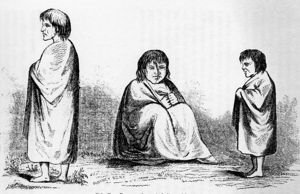
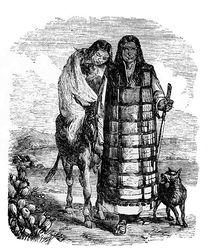


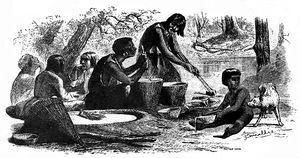
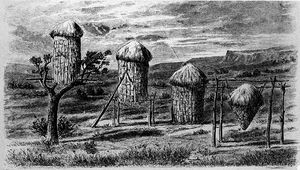

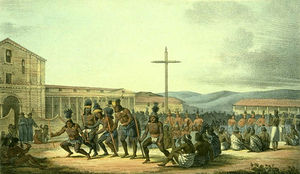
![(PD) Painting: Louis Choris The Ohlone, Coast Miwok, and Bay Miwok all utilized utilized tule in the construction of boats for use in the San Francisco Bay estuary. Northern groups of Chumash also used tule to build reed fishing canoes.[1]](/wiki/images/thumb/6/6d/Tule_boat.jpg/300px-Tule_boat.jpg)


![(PD) Photo: Charles C. Pierce The San Antonio de Pala Asistencia (or "Pala Mission" as it is known today) circa 1900. Pala is architecturally unique among all of the Franciscan missions in that it boasts the only completely freestanding campanile, or "bell tower," in all of Alta California. It is also the only outpost that has ministered without interruption to the Mission Indians for whom it was originally built since its inception, and is the only "sub-mission" still intact.[2]](/wiki/images/thumb/7/7a/CHS-46640.jpg/300px-CHS-46640.jpg)
![(PD) Photo: Charles C. Pierce Mission San Luis Rey de Francia is home to with the first Peruvian Pepper Tree (Schinus molle) planted in California in 1830, visible at right behind the arches in the above photograph (taken circa 1900).[3]](/wiki/images/thumb/f/fa/CHS-2097.jpg/199px-CHS-2097.jpg)


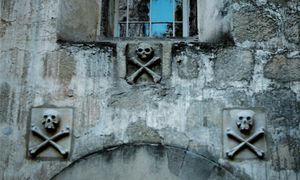

![(PD) Photo: Joe Radigan MACM / United States Navy Between 1944 and 1945, twenty-seven Mission Buenaventura-class fleet oilers were built (two additional vessels were converted to distilling ships after their keels had been laid).[4] Many of the ships, such as the USNS Mission Capistrano (T-AO-112) shown above, served with the United States Navy during World War II and on into the Cold War.](/wiki/images/thumb/1/11/USNS_Mission_Capistrano.jpg/300px-USNS_Mission_Capistrano.jpg)